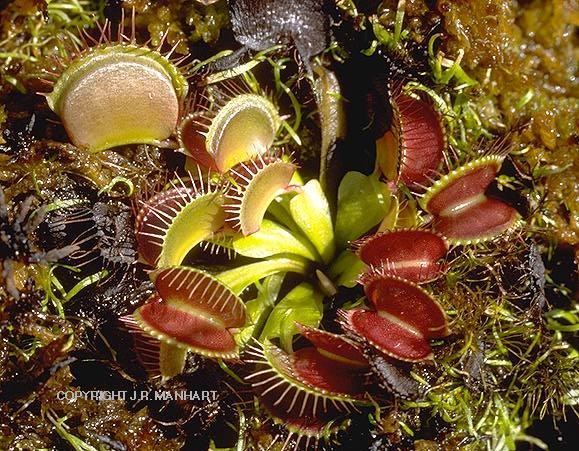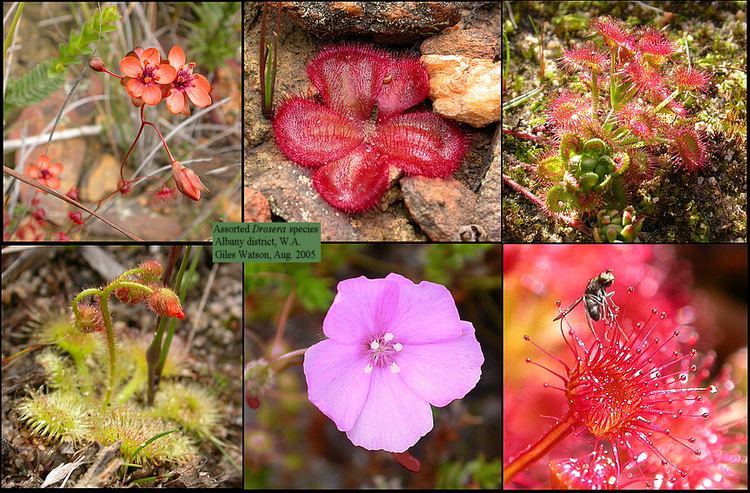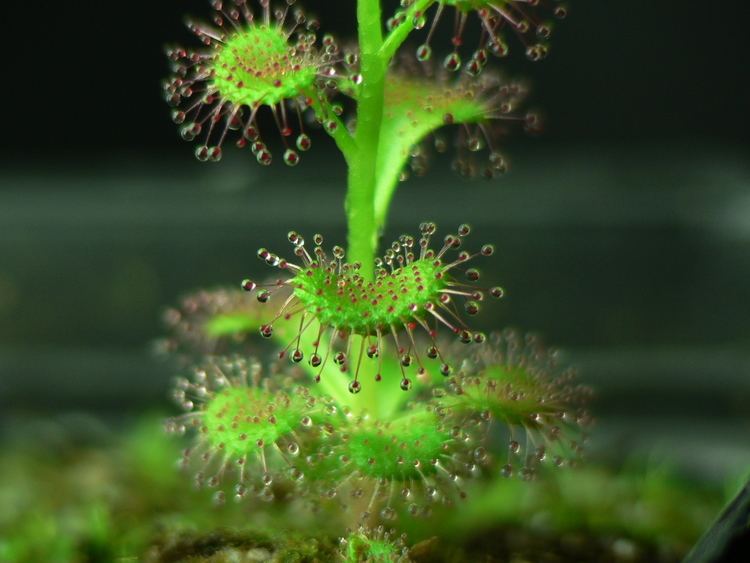Scientific name Droseraceae Rank Family | ||
 | ||
Lower classifications Sundews, Venus flytrap, Aldrovanda vesiculosa, Aldrovanda, Aldrovanda inopinata | ||
Flora view zonnedauw drosera sundew droseraceae
Droseraceae is a family of flowering plants. The family is also known as the sundew family. It is a small family of carnivorous plants, which consist of approximately 180 species in three extant genera:
Contents
- Flora view zonnedauw drosera sundew droseraceae
- Description
- Drosera
- Dionaea
- Aldrovanda
- Phylogeny
- References

Description

Most of the members of Droseraceae are contained in Drosera, the true sundews. Both Dionaea and Aldrovanda have only one extant species. Droseras secrete a sticky substance from their leaves that traps prey. Dionaea and Aldrovanda both use snap-traps that close rapidly when the leaves are disturbed, Dionaea is terrestrial, while Aldrovanda is strictly aquatic. Like carnivorous plants of other families, the Droseraceae are able to supplement their nutrient intake, especially that of nitrogen, by capturing and digesting small animals such as insects. In this way, these plants are able to thrive in nutrient-deficient areas, such as sphagnum bogs.
Drosera

Drosera is one of the largest genera of carnivorous plants, and individual species vary extensively in their specific morphology. Common to all members of Drosera are highly modified leaves lined with tentacle-like glandular trichomes. At the end of each trichome, a bead of highly viscous mucilage is secreted, which resembles a drop of dew. The mucilage is a fairly pure aqueous solution of acidic polysaccharides with high molecular weights, which makes the mucilage not only highly viscous, but also very sticky, so much so, a single drop of mucilage may be stretched to lengths of up to a meter and cover one million times its original surface area. Insects and other prey animals are attracted by the smell of this mucilage and become stuck in it. Such snares are termed “flypaper traps”, but the trapping mechanism of sundews is often erroneously described as “passive”. In fact, sundew traps are quite active and sensitive, and the disturbance of one or a few trichomes quickly triggers an action potential that stimulates the rapid movement of other trichomes toward the prey. The leaf then curls in on itself, enveloping the prey for digestion.
Dionaea

Dionaea muscipula, better known as the Venus flytrap, is a globally famous carnivorous plant and according to Charles Darwin, “one of the most wonderful in the world.” The leaves of Dionaea are also highly modified and form a “snap-trap” that quickly shuts when a stimulus is detected. Three large trichomes extend outward on the inner surface of the trap. Two of these three hairs must be stimulated within a certain amount of time to trigger the trap. The trap closes as the result of a flipping of the trap lobes from a position where the exterior of the trap is concave to one where the exterior is convex. This movement can begin as soon as 0.4 seconds after stimulation and can be completed after one second.
Aldrovanda

Aldrovanda vesiculosa, also called the waterwheel plant, is less well-known than its relative Dionaea muscipula, but the two have similar trap structures. The trap of Aldrovanda is aquatic and is smaller and faster than that of Dionaea. In addition, while two stimuli are required to close a trap in Dionaea, only one is required in Aldrovanda. The trap of Aldrovanda closes about ten times faster than that of Dionaea.
Phylogeny

Despite some debate, taxonomists have tended to include at least two of the three genera, and, in general, all three, in this family since at least 1906. Separate families for Dionaea and Aldrovanda have been proposed in the past. These were Dionaecae, proposed in 1933, and Aldrovandaceae, proposed in 1949. Ultimately, molecular and morphological evidence support the inclusion of all three, and also shows the two genera with traps that snap shut (Dionaea and Aldrovanda) are more closely related to each other than to Drosera, suggesting snap traps evolved only once.
The family Droseraceae is part of the order Caryophyllales in the clade core eudicots. The family totals nearly 200 species. Caryophyllales are divided into two major suborders: Caryophyllineae, which contains the “core” Caryophyllales, such as Cactaceae and Amaranthaceae and is sister to the Polygonineae – the “non-core” Caryophyllales. This non-core clade is where Droseraceae is placed.
In the past, Drosophyllum lusitanicum has been included in this family. Drosophyllum, another monotypic genus, exhibits a flypaper-type trap similar to those of Drosera, but Drosophyllum does not actively curl its leaves to envelop captured prey animals. This important morphological distinction led researchers to question the validity of this taxon’s placement in Droseraceae. Other significant trait differences in Drosophyllum include pollen structure, trichome anatomy, and a woody stem with a deep taproot. Ultimately, Drosophyllum was shown to be more closely related to the carnivorous liana Triphyophyllum and the noncarnivorous liana Ancistrocladus, and is, thus, classified elsewhere (to be specific, its own monotypic family Drosophyllaceae). Recent molecular and biochemical evidence (see the AP-Website) suggests the carnivorous taxa in the order Caryophyllales (the families Droseraceae, Drosophyllaceae, Nepenthaceae, and the species Triphyophyllum peltatum) all belong to the same clade, which does not consist only of carnivorous plants, but also of some noncarnivorous plants such as those in the family Ancistrocladaceae.
The fossil record of Droseraceae is the richest of any carnivorous plant family. Fossil pollen has been attributed to several extant, as well as extinct, genera, although some are of questionable validity.
